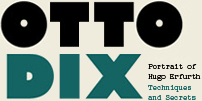

Otto Dix
Hugo Erfurth with Dog, 1926 (detail of the holes)
Tempera and oil on panel. 80 x 100 cm.
Museo Thyssen-Bornemisza, Madrid
Hugo Erfurth with Dog, 1926 (detail of the holes)
Tempera and oil on panel. 80 x 100 cm.
Museo Thyssen-Bornemisza, Madrid
HOLES
In the upper corners of the painting there are two holes, one on each side, possibly corresponding to the metal thumbtacks used to hold the cartoon used by Dix to trace the preliminary sketch onto the final support.
In the upper corners of the painting there are two holes, one on each side, possibly corresponding to the metal thumbtacks used to hold the cartoon used by Dix to trace the preliminary sketch onto the final support.

Otto Dix
Hugo Erfurth with Dog, 1926 (detail of the side)
Tempera and oil on panel. 80 x 100 cm.
Museo Thyssen-Bornemisza, Madrid
Hugo Erfurth with Dog, 1926 (detail of the side)
Tempera and oil on panel. 80 x 100 cm.
Museo Thyssen-Bornemisza, Madrid
SIDE
Cross section of the painting showing the different strata making it up. In the front it is possible to appreciate the different ground and paint layers, as well as the plywood support. The back also shows a new ground layer, a procedure traditionally used to prevent the support from warping.
Cross section of the painting showing the different strata making it up. In the front it is possible to appreciate the different ground and paint layers, as well as the plywood support. The back also shows a new ground layer, a procedure traditionally used to prevent the support from warping.

Otto Dix
Hugo Erfurth with Dog, 1926 (detail of the signature)
Tempera and oil on panel. 80 x 100 cm.
Museo Thyssen-Bornemisza, Madrid
Hugo Erfurth with Dog, 1926 (detail of the signature)
Tempera and oil on panel. 80 x 100 cm.
Museo Thyssen-Bornemisza, Madrid
SIGNATURE
In keeping with the Old Masters, Dix uses an anagram—“19D26”—to sign his painting.
In keeping with the Old Masters, Dix uses an anagram—“19D26”—to sign his painting.

Otto Dix
Hugo Erfurth with Dog, 1926 (detail rear)
Tempera and oil on panel. 80 x 100 cm.
Museo Thyssen-Bornemisza, Madrid
Hugo Erfurth with Dog, 1926 (detail rear)
Tempera and oil on panel. 80 x 100 cm.
Museo Thyssen-Bornemisza, Madrid
BACK
Two inscriptions signed by Dix on the back provide information about the painting. The first refers to the technique used and offers advice on handling:
“Mixed technique. Last layer oil. Linseed oil.”
“It should not be varnished before Sept. 27. Dix”
The second, smaller in size and located in the upper right corner, gives detailed information about the varnish’s commercial brand: “Lukas matt. Mixed with beeswax 50/50.”
Two inscriptions signed by Dix on the back provide information about the painting. The first refers to the technique used and offers advice on handling:
“Mixed technique. Last layer oil. Linseed oil.”
“It should not be varnished before Sept. 27. Dix”
The second, smaller in size and located in the upper right corner, gives detailed information about the varnish’s commercial brand: “Lukas matt. Mixed with beeswax 50/50.”















